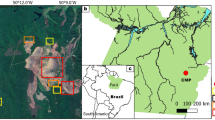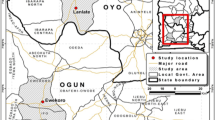Abstract
Purpose
The objective of this study was to examine the pedogenetic evolution occurring in technic hard materials from an iron mine through the characterization of a chronosequence of 0-, 15-, and 40-year-old Technosols and an older natural soil.
Materials and methods
Samples were taken from Technosols of different ages (0, 15, 40 years) which had developed after a layer of crushed conglomerate was placed over the top of the mine tailings, as well as from a natural soil developed on conglomerate which represented the most advanced evolutionary stage in the chronosequence. Analyses of soil micromorphological, physical, chemical, and mineralogical properties included grain size distribution; pH; electric conductivity (EC); organic matter; exchangeable bases; N-NO3; available P, Fe, Zn, Mn, Cu, and B micronutrients; and clay mineralogy (by X-ray diffraction).
Results
Results showed that 15- and 40-year-old Technosols already displayed an advanced structural development and nutrient contents comparable to those in the studied natural soil. Such a rapid pedogenesis was due to the high clay content found within the conglomerates which can be easily incorporated into the soil and reordered within the soil groundmass. The tailings were characterized by a neutral pH (6.9) and a high EC (0.188 S m−1), which decreased in the upper horizons of the 15-year-old Technosols, conforming thionic horizons. Generally, similar clay mineral assemblages dominated by smectite were observed in the conglomerate, the natural soil, and the 40-year-old Technosol.
Conclusion
This study confirms the possibility of rehabilitating iron mine tailings with a layer of conglomerate, which mitigates against the adverse effects of mining. Results showed that the conglomerate can easily evolve into a soil within a relatively short period. However, the conglomerate cover should be thick enough to avoid acidification of the topsoil.








Similar content being viewed by others
References
Akala V, Lal R (2000) Potential of mine land reclamation for soil organic carbon sequestration in Ohio. Land Degrad Dev 11:289–297. https://doi.org/10.1002/1099-145X(200005/06)11:3%3C289::AID-LDR385%3E3.0.CO;2-Y
Ahirwal J, Maiti S (2018) Development of Technosol properties and recovery of carbon stock after 16 years of revegetation on coal mine degraded lands, India. Catena 166:114–123. https://doi.org/10.1016/j.catena.2018.03.026
Belousova NI, Berkgaut VV, Vasenev I, Pavlova EB (1992) Podzolic soils on basic rocks. Eurasian Soil Sci 24(6):6–17
Barrow NJ (2017) The effects of pH on phosphate uptake from the soil. Plant Soil 410(1–2):401–410. https://doi.org/10.1007/s11104-016-3008-9
Blum WEH (2005) Functions of soil for society and the environment. Rev Environ Sci Bio/Technol 4:75–79. https://doi.org/10.1007/s11157-005-2236-x
Brown S, Trlica A, Lavery J, Teshima M (2017) Carbon sequestration potential on mined lands. In: Bolan NS, Kirkham MB, Ok YS (Eds) Spoil to soil: mine site rehabilitation and revegetation. CRC Press pp 189–200. https://doi.org/10.1201/9781351247337
Camprubí A, Canet C (2009) Comment to Berthierine and chamosite hydrothermal: genetic guides in the Peña Colorada magnetite-bearing ore deposit, Mexico. Earth Planets Space 61:291–295
Camprubí A, Centeno-García E, Tolson G, Iriondo A, Ortega B, Bolaños D, Abdullin F, Portugal-Reyna JL, Ramos-Arias MA (2018) Geochronology of Mexican mineral deposits. VII: the Peña Colorada magmatic-hydrothermal iron oxide deposits (IOCG “clan”), Colima. Bol Soc Geol Mex 70:633‒674. https://doi.org/10.18268/BSGM2018v70n3a4
CONAGUA (2019) Comision Nacional del Agua, National Weather Service, https://smn.conagua.gob.mx/tools/RESOURCES/Estadistica/6039.pdf. Accessed 11 Nov 2019
Chernyakhovsky AG, Gradusov BP, Chizhikova NP (1976) Types of recent weathering crusts and their global distribution. Geoderma 16:235–255. https://doi.org/10.1016/0016-7061(76)90025-2
Corona R, Henríquez F (2004) Modelo magmático del yacimiento de Hierro Peña Colorada, Colima y su relación con la exploración de otros yacimientos de hierro en México. Bol Soc Geol Mex 113
Corona R, Tritlla J, Henríquez F , Morales I, Portugal JL, Nava LP (2009) Geología y mineralización del Yacimiento Peña Colorada. In: Clarck K, Salas-Pizá GA, Cubillas-Estrada R (Eds). Geología Economica de México, Servicio Geoólogico Mexicano 2a edición, pp 522–528. https://www.geologia.unam.mx:8080/igl/publs/boletin/b113.pdf
Coward EK, Thompson AT, Plante AF (2017) Iron-mediated mineralogical control of organic matter accumulation in tropical soil. Geoderma 306:206–216. https://doi.org/10.1016/j.geoderma.2017.07.026
Dane JH, Topp GC (2002) Methods of soil analysis. Part 4. Physical methods. Soil Sci. Soc. Am. Book Series No. 5. Soil Science Society of America, Inc. Madison, Wisconsin
Daniell A, Van-Deventer PW (2018) An overview of pedogenesis in Technosols in South Africa. South African Plant and Soil 35:281–291. https://doi.org/10.1080/02571862.2018.1470265
Doran JW (2002) Soil health and global sustainability: translating science into practice. Agric Ecosyst Environ 88:119–127. https://doi.org/10.1016/S0167-8809(01)00246-8
Frouz J, Keplin B, Pižla V, Tajovský K, Starý J, Lukešová A, Nováková A, Balı́k V, Háněl L, Materna J, Düker C, Chalupský J, Rusek J, Heinkele T, (2001) Soil biota and upper soil layer development in two contrasting post-mining chronosequences. Ecol Eng 17:275–284. https://doi.org/10.1016/S0925-8574(00)00144-0
Huot H, Simonnot MO, Marion P, Yvon J, De-Donato PJ, Morel L (2013) Characteristics and potential pedogenetic processes of a Technosol developing on iron industry deposit. J Soils Sediments 13:555–556. https://doi.org/10.1007/s11368-012-0513-1
Huot H, Simonnot M, Morel JL (2015) Pedogenic trends in soils formed in technogenic parent materials. Soil Sci 180(4/5):182–192
Ibarra-Arzave G, Romero-Lázaro E, Solleiro-Rebolledo E, Sedov S, Barceinas H, López-Martínez R, Chávez-Vergara B, Pi-Puig T, Calmus T (2019) Paleopedogenesis, sedimentation and holocenic geomorphologic evolution in the fluvial system of Arroyo Tinajas, Sonora. Rev Mex Cienc Geológ 36:378–392
IUSS Working Group WRB (2015) World Reference Base for Soil Resources 2014, update 2015 International soil classification system for naming soils and creating legends for soil maps. World Soil Resources Reports No. 106. FAO, Rome IT EU, p 192
Jongmans AG, Van Oort F, Nieuwenhuyse A, Buurman P, Jaunet AM, van Doesburg JDJ (1994) Inheritance of 2:1 phyllosilicates in Costa Rican Andisols. Soil Sci Soc Am J 58:494–501
Krechetov P, Chernitsova O, Sharapova A, Terskaya E (2019) Technogenic geochemical evolution of Chernozems in the sulfur coal mining areas. J Soils Sediments 19:3139–3154. https://doi.org/10.1007/s11368-018-2010-7
Kuter N, Dilaver Z, Gül E (2014) Determination of suitable plant species for reclamation at an abandoned coal mine area. Int J Min Reclam Environ 28(5):268–276. https://doi.org/10.1080/17480930.2014.932940
Lang JR, Baker T (2001) Intrusion-related gold systems: the present level of understanding. Mineral Deposita 36:477–489
Lindsay WL (1979) Chemical Equilibria in Soils. JohnWiley and Sons Ltd., Hoboken, NJ, USA
Lomaglio T, Hattab-Hambli N, Bret A, Miard F, Trupiano D, Scippa GS, Motelica-Heino M, Bourgerie S, Morabito D (2017) Effect of biochar amendments on the mobility and (bio) availability of As, Sb and Pb in a contaminated mine technosol. J Geochem Explor 182:138–148. https://doi.org/10.1016/j.gexplo.2016.08.007
Loaiza JC, Stoops G, Poch RM, Casamitjana M (2015) Manual de micromorfología de suelos y técnicas complementarias. Fondo Editorial Pascual Bravo. Medellín, Colombia 384
Mukhopadhyay S, Maiti SK, Masto RE (2014) Development of mine soil quality index (MSQI) for evaluation of reclamation success: a chronosequence study. Ecol Eng 71:10–20
Nordstrom DK, Alpers CN (1999) Geochemistry of acid mine waters. In environmental geochemistry of mineral deposits. In: Plumlee GS, Logsdon MJ (Eds), Soc Econ Geol Inc V. 6A, Littleton CO: 133–160. https://doi.org/10.5382/Rev.06.06
Penn Ch J, Camberato JJ (2019) A critical review on soil chemical processes that control how soil pH affects phosphorus availability to plants. Agriculture 9(6):20 https://doi.org/10.3390/agriculture9060120
Pirajno F (2010) Hydrothermal processes and mineral systems. Springer Science+Business Media B.V., reprinted with corrections, p 1250
Rivera-Uria MY, Martin-Romero F, Sedov S, Ramos D, Solleiro-Rebolledo E, Diaz-Ortega, J (2019) Effects of the interaction between an acid solution and pedogenic carbonates: the case of Buenevista del Cobre Mine Mexico. Revista Mexicana de Ciencias Geologicas 36(6):308–320. https://doi.org/10.22201/cgo.20072902e.2019.3.1039
Rodríguez-Vila A, Forján R, Guedes RS, Covelo EF (2017) Nutrient phytoavailability in a mine soil amended with technosol and biochar and vegetated with Brassica juncea. J Soils Sediment 17:1653–1661. https://doi.org/10.1007/s11368-016-1643-7
Romero-Lázaro EM, Ramos-Pérez D, Romero FM, Sedov S (2019) Indicadores indirectos de contaminación residual en suelos y sedimentos de la cuenca del Río Sonora, México. Rev Int Contam Ambient 35: 371–386. https://doi.org/10.20937/rica.2019.35.02.09
Rzedowski J (2006) Vegetación de México. 1 ar edición digital, Comisión Nacional para el Conocimiento y Uso de la Biodiversidad, México, p 504
Santomartino S, Webb JA (2007) Estimating the longevity of limestone drains in treating acid mine drainage containing high concentrations of iron. Appl Geochem 22(11):2344–2361. https://doi.org/10.1016/j.apgeochem.2007.04.020
Santos ES, Abreu MM, Macías F (2019) Rehabilitation of mining areas through integrated biotechnological approach: Technosols derived from organic/inorganic wastes and autochthonous plant development. Chemosphere 224:765–775. https://doi.org/10.1016/j.chemosphere.2019.02.172
Scalenghe R, Ferraris S (2009) The first forty years of a Technosol. Pedosphere 19:40–52. https://doi.org/10.1016/S1002-0160(08)60082-X
Sedov SN, Malinin OI, Shoba SA (1989) Autonomous taiga soil formation on the southwest coast of the sea of Okhotsk. Pochvovedeniye 11:24–35
Sedov SN, Vaseneva EG, Shoba SA (1993) Recent and ancient weathering in soils on the basic rocks of Valamo island. Eurasian Soil Sci 25:22–37
Stoops GJ (2001) Guidelines for thin section description. Laboratorium voor mineralogie, pretrologie en micropedologie. Universiteit Gent, Belgium.
Targulian VO, Krasilnikov PV (2007) Soil system and pedogenic processes: self-organization, time scales, and environmental significance. Catena 71:373–381. https://doi.org/10.1016/j.catena.2007.03.007
Toktar M, Lo Papa G, Kozybayeva FE, Dazzi C (2016) Ecological restoration in contaminated soils of Kokdzhon phosphate mining area (Zhambyl region, Kazakhstan). Ecol Eng 86:1–4. https://doi.org/10.1016/j.ecoleng.2015.09.080
Tritlla J, Camprubí A, Centeno E, Corona R, Iriondo A, Sánchez S, Morales P (2003) Estructura y edad del depósito de hierro de Peña Colorada, Colima: un posible equivalente fanerozoico de los depósitos de tipo IOCG. Revista Mexicana de Ciencias Geológica 20:182–201 ISSN: 1026–8774. https://www.redalyc.org/articulo.oa?id=57220303
Uzarowicz L (2013) Microscopic and microchemical study of iron sulphide weathering in a chronosequence of technogenic and natural soils. Geoderma Volumes 197–198:137–150. https://doi.org/10.1016/j.geoderma.2013.01.006
Watteau F, Huot H, Sere G, Begin C, Rees F, Schwartz C, Morel JL (2018) Micropedology to reveal pedogenic processes in Technosols. Spanish Journal of Soil Science 8:148–163. https://doi.org/10.3232/SJSS.2018.V8.N2.02
Walker TW, Syers JK (1976) The fate of phosphorus during pedogenesis. Geoderma 15:1–19. https://doi.org/10.1016/0016-7061(76)90066-5
Zhao Z, Shahrour I, Baia Z, Fan W, Feng L, Li H (2013) Soils development in opencast coal mine spoils reclaimed for 1–13 years in the West-Northern Loess Plateau of China. Eur J Soil Biol 55:40–46. https://doi.org/10.1016/j.ejsobi.2012.08.006
Zürcher L, Ruiz J, Barton MD (2001) Paragenesis, elemental distribution and stable isotopes at the Peña Colorada iron skarn. Colima, México: Economic Geology 96:535–557
Acknowledgements
We are grateful to Astrid Vazquez S. (Environmental Geochemistry Laboratory at the National Laboratory of Geochemistry and Mineralogy (LANGEM) of Geology Institute, UNAM) for carrying out the geochemical analysis, and Teresa Pi Puig by X Ray diffraction analysis (LANGEM).
Author information
Authors and Affiliations
Contributions
All authors of this manuscript made substantial contributions to the manuscript and qualify for authorship, and no authors have been omitted.
Corresponding author
Ethics declarations
If any of the sections are not relevant to your manuscript, please include the heading and write “Not applicable” for that section. We declare all data are shown into the main document.
Conflict of interest
The authors declare no competing interests.
Additional information
Responsible editor: Claudio Bini
Publisher's Note
Springer Nature remains neutral with regard to jurisdictional claims in published maps and institutional affiliations.
Rights and permissions
About this article
Cite this article
Ortega, J.D., Sedov, S., Romero, F. et al. Chronosequence of Technosols at the Peña Colorada mine in Colima, Mexico: a short-term remediation alternative. J Soils Sediments 22, 942–956 (2022). https://doi.org/10.1007/s11368-021-02990-3
Received:
Accepted:
Published:
Issue Date:
DOI: https://doi.org/10.1007/s11368-021-02990-3




